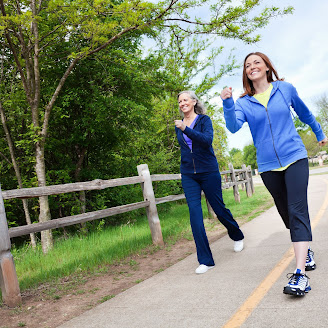
Tips For A Better Walk
People are often surprised to learn that there's more to walking than simply putting one foot in front of the other. In fact, a little technique goes a long way to making your walks more enjoyable and more effective. Technique is especially important if you are hoping to become fitter and lose weight, because it will enable you to walk faster and longer. When you're standing tall, your muscles will move through a greater range of motion for a more powerful stride. Improving your walking posture will help you to look and feel more confident, too—and you'll look slimmer before losing a single pound. It will also help alleviate aches and pains and allow you to take deep breaths for more energy.
The following rules will help you maintain good form.
1. Stand tall. Many people bring that hunched-over- the-computer posture to their walks. This position makes it harder for you to breathe and may contribute to backaches. Other people lean backward. Instead, extend your spine as if you were being lifted from the crown of your head. Place your thumbs on your lower ribs and your fingertips on your hips. As you stand up tall, notice how the distance in between increases. Try to maintain this elongation as you walk.
3. Shoulders back, down, and relaxed. Roll your shoulders up, back, and then down. This is where your shoulders should be as you walk—not pulled up toward your ears. Think about keeping your shoulders away from your ears to reduce upper-body tension and allow for a freer arm swing.
4. Swing from your shoulders. Let your arms swing freely from your shoulders, not your elbows. Swing your arms forward and back, like a pendulum. Don't bring them across your body or let them go higher than your chest.
5. Maintain a neutral pelvis. Keep your abs tight, but don't tuck your tailbone under or stick your belly out and overarch your back.
6. Step lightly. You should be rolling from heel to toe as you stride, not landing flat-footed with a thud. And don't reach your leg far out in front of you. That increases impact on your joints and actually slows you down. You want a smooth, quiet stride—no bouncing or plodding along—to reduce your risk of injury.
When you are walking correctly, your body is performing at it's best. You will possibly have less stress. Less body aches and pains. I haven't touched on the importance of wearing the correct shoes while walking here. Perhaps that's another blog post.
Have a great day
Nancy




No comments:
Post a Comment
Note: Only a member of this blog may post a comment.